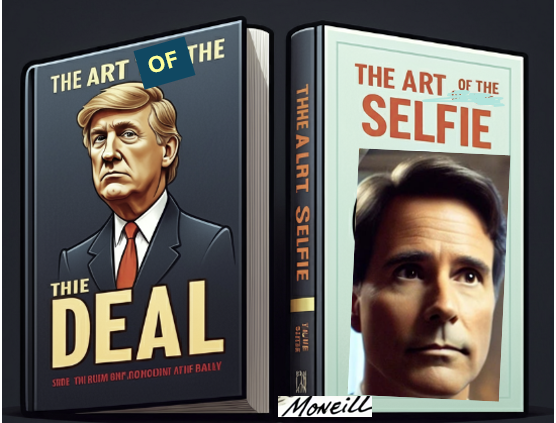
By Michael O’Neill
“Nothing says winter in Canada like snowbirds flocking south to warmer climes. This year, the Loonie has joined the migration, donning a sombrero and singing, “Tariffs make me holler—Now I’m a peso, not a dollar.'”
President-elect Donald Trump announced that one of the first actions he will take as President will be to slap 25% tariffs on all imports of goods from Canada and Mexico. And in his tweet, he capitalized “ALL.”
Canadian’s were gobsmacked. How could Trump compare us to Mexico? After all, Canada has a well developed economy and is a member in good standing of the G-7. Mexico, on the other hand is a low income, drug-cartel ridden, corrupt third world country.
And we have a trade agreement. The United States Mexico Canada Agreement on trade (USMC) was signed by Trump and Trudeau on November 30, 2018, effective July 1, 2020. The deal covers a wide range of Canadian exports including Energy, Automotive, Agricultural, Forestry products as well as Manufactured Goods, Minerals and Mining.
Surely that means we are protected.
It doesn’t.
Throwing Down the Gauntlet

Trump’s tariff threat relies on a broad interpretation of national security. Historically, these laws focused on defense-related imports, but the definition has since expanded to cover broader concerns like immigration and economic reliance on foreign goods. Trump’s assertion that “Crime and Drugs at levels never seen before” are pouring in through Mexico and Canada, hints at how he plans to frame the issue.
He also has other tools. He could levy tariffs by using the International Emergency Economic Powers Act (IEEPA). Under this act, Trump can declare a national emergency and argue that illegal immigration and drug trafficking represent an emergency requiring swift action, including tariffs as leverage.
In a stretch he could use Section 301 of the Trade Act of 1974. This provision allows the president to respond to unfair trade practices by foreign governments which Trump could argue includes inadequate border control or perceived failures in addressing drug trafficking.
Negotiating is an Art

Canada went into the USMCA negotiations at a disadvantage. The American’s were led by a man who was extremely proficient in negotiating deals while Canada had to make do with a “selfie King.” No wonder Canada got Trumped.
Trump used leverage masterfully. Even after the USMCA was signed, he slapped tariffs on Canadian steel and aluminum to force additional concessions before ratification as he was well aware that Canada needed a deal far more than the USA. In his book Trump wrote about tactics, such as applying pressure or creating a sense of urgency, to tip the scales in one’s favor while be willing to walk away. The strategy was a winner. Trump won additional concessions from Trudeau which included dairy market access and a change to the milk pricing system. In addition, Canada was forced to ease some of its cultural protections which gave more access to US media and entertainment companies.
Thrown for a Loop

The Bank of Canada was feeling rather smug. On November 26, Deputy Governor Rhys Mendes delivered a speech titled “Sticking the Landing: Keeping Inflation at 2.0%,” signaling that policymakers believed inflation was under control.
They shouldn’t be. The Trudeau government recently announced another $4.5 billion spending plan designed to boost Liberal politicians in the polls in the guise of a GST tax holiday followed by a $250 cheque for those earning less than $150,000/year sometime in the spring. Finance Minister Chrystia Freeland tweeted “This spring, Canadian workers making less than $150,000/year will receive a $250 rebate. We’re making life a bit easier, so you have a little more money in your pockets. Vote Liberal” (ok the last part is fake news).
Under normal circumstances, this announcement would be inflationary. Lower taxes and extra cash raise demand, potentially driving prices higher. But these are not normal times. Parliament has been gridlocked since September after the House passed a Conservative motion demanding documents on the mismanagement of Sustainable Development Technology Canada. Until this standoff is resolved, the fiscal stimulus remains just political promises.
But that’s the big picture
The reality is Trump does not take power until January 20 and everything he says is just noise until that point. The tariff tweet is just the opening salvo of what will be a protracted discussion, and Mr Trump will also have to reckon with powerful, border state governors. The economies of those states are intertwined with the Canadian provinces and Trump’s tariff actions could have serious economic repercussions in the US as well.
FX traders have no patience for political drama. All they see is mounting pressure on Canadian exports as U.S. tariffs loom. With Trump likely to repeat his past success in wringing concessions from Canada, traders are bracing for a difficult 2024. The result? USDCAD is set to trade in a wide range of 1.3900–1.4500, at least through January.
As the Loonie joins the mariachi band, one thing is clear: the winter of 2024/25 is shaping up to be a long, cold one for Canada’s economy.





